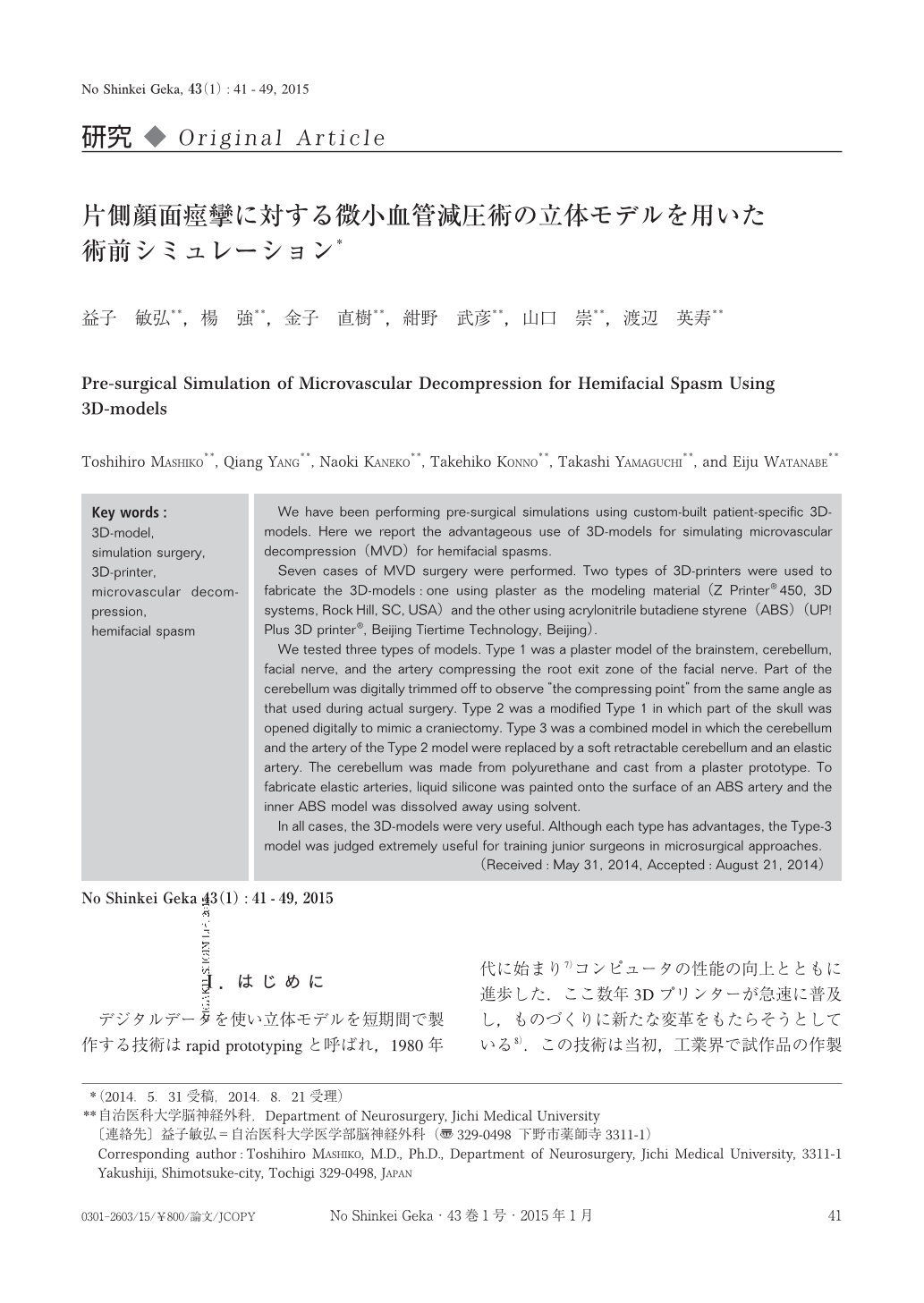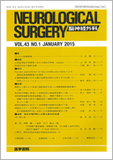Japanese
English
- 有料閲覧
- Abstract 文献概要
- 1ページ目 Look Inside
- 参考文献 Reference
Ⅰ.はじめに
デジタルデータを使い立体モデルを短期間で製作する技術はrapid prototypingと呼ばれ,1980年代に始まり7)コンピュータの性能の向上とともに進歩した.ここ数年3Dプリンターが急速に普及し,ものづくりに新たな変革をもたらそうとしている8).この技術は当初,工業界で試作品の作製などに用いられていたが,1990年代より医学分野にも徐々に応用されるようになっている4,6,13).
われわれは2012年に2台の3Dプリンターを導入した.1台は3D Systems社(Rock Hill, SC USA)Z Printer® 450(以下,Zプリンターと記載,Fig.1E)で,石膏を材料とするものである.もう1台はBeijing Tiertime Technology社(北京)製UP! Plus 3D Printer®(以下,UP!プリンターと記載,Fig.1F)で,acrylonitrile butadiene styrene(ABS)樹脂を材料とするものである.これらを用いて100例以上の手術症例で,工夫を重ねながら立体モデルによる手術シミュレーションを行った.その経験から,実体モデルを手にとって観察することはコンピュータ・グラフィックス(CG)に比較し格段に有用であると考えるに至った.
これまで手術症例数の多い脳腫瘍・脳動脈瘤などの症例が中心であったが,症例を重ねる中で同法が微小血管減圧術(microvascular decompression:MVD)に対してきわめて有効であるとの感触を得た.この手術に3次元CG画像によるシミュレーションが有用であるとの先行研究があるが2,10),実体モデルはそれと同様かそれ以上に有用であることが期待される.われわれは,軟質中空の脳動脈瘤モデルを実際にクリッピングすることで非常に有効な術前シミュレーションが可能であることを既に報告したが9),今回はさらに,圧排できる軟らかい小脳モデルを開発した.これと軟性動脈モデルを石膏モデルに組み合わせて,小脳の圧排から責任血管のtranspositionやinterpositionのシミュレーションを行えるモデルを作製し,従来の石膏モデルとの比較を行った.
We have been performing pre-surgical simulations using custom-built patient-specific 3D-models. Here we report the advantageous use of 3D-models for simulating microvascular decompression(MVD)for hemifacial spasms.
Seven cases of MVD surgery were performed. Two types of 3D-printers were used to fabricate the 3D-models:one using plaster as the modeling material(Z Printer®450, 3D systems, Rock Hill, SC, USA)and the other using acrylonitrile butadiene styrene(ABS)(UP! Plus 3D printer®, Beijing Tiertime Technology, Beijing).
We tested three types of models. Type 1 was a plaster model of the brainstem, cerebellum, facial nerve, and the artery compressing the root exit zone of the facial nerve. Part of the cerebellum was digitally trimmed off to observe “the compressing point” from the same angle as that used during actual surgery. Type 2 was a modified Type 1 in which part of the skull was opened digitally to mimic a craniectomy. Type 3 was a combined model in which the cerebellum and the artery of the Type 2 model were replaced by a soft retractable cerebellum and an elastic artery. The cerebellum was made from polyurethane and cast from a plaster prototype. To fabricate elastic arteries, liquid silicone was painted onto the surface of an ABS artery and the inner ABS model was dissolved away using solvent.
In all cases, the 3D-models were very useful. Although each type has advantages, the Type-3 model was judged extremely useful for training junior surgeons in microsurgical approaches.

Copyright © 2015, Igaku-Shoin Ltd. All rights reserved.


